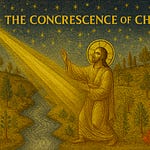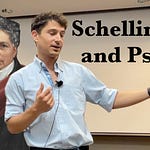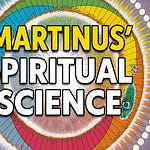I began by referencing a conversation that Simon was recently involved in convened by
(Voicecraft about the question “Is the earth enough?”). I invited Simon to share any lingering ideas or questions from those conversations. Simon reflects that the second episode was packed with “a lot of broad frameworks for thinking about the world,” and by the end of it he was quite full, trying to feel into what still seemed relevant for him. He explains that he is drawn to the question of the direct experiencing of concepts such as the noosphere or “earth’s consciousness.” If the universe is alive and everything has an interior, how might we communicate with these beings?Simon then introduces the topic of nonphysical astral beings by talking about Carl Hayden Smith, who is involved in “DMTx” explorations, an extended DMT experience that Simon describes as “super sci-fi” yet “very, very real.” He calls it “a form of space travel” that is totally different from the materialist framework. He finds it exciting that, rather than building computer interfaces, people are “installing psychotechnological interfaces or energetic interfaces” for human consciousness to communicate with what some esoteric traditions call astral beings.
I responded by considering the idea of portals being opened through practices like extended DMT, mentioning that some people encounter alien intelligences (or what McKenna famously called “machine elves”) who seem surprised to see humans—almost as if the humans got there by mistake. I wondered if there is any risk of disturbing other dimensions that we don’t belong in, which prompts Simon to recount a journey in which he literally saw a portal above him and sensed the beings within it thinking, “Oh, he’s seeing us!” before the portal closed. Simon jokes that humans might be bumbling fools in these realms, and therefore not quite capable of serious harm.
Sam poses the question of whether these astral encounters induced by psychedelics are the same places we go at night in dreams. He also wonders if we are practicing “spiritual colonialism,” barging into territories uninvited. I see the dream state as more of a regular part of the human rhythm and suggested that psychedelics, especially something as potent as DMT, might represent a different type of portal that can lead people to engage in a kind of “gate crashing” into astral realms they are not spiritually prepared for. We discuss the possibility that encountered entities might want to teach or engage, or might resent the disturbance if we show up with the wrong intentions.
Simon recounts Carl Hayden Smith’s report of repeatedly encountering the same entities in extended DMT sessions. At one point, they seemed to think he was coming too frequently, telling him he needed to integrate whatever they had already shared with him. I asked whether there is any attempt in these DMT experiments to coordinate experiences—do different people see the same beings or not? I wonder if the rules are all different on the astral plane, and whether we can build a science of the astral realm. Simon then imagines a frightening possibility of “multidimensional colonialism,” where humans apply “the same strategy as the Europeans did” centuries ago, but this time in other realms. Matt jokes that if karma applies, “the Europeans should be careful.”
The conversation turns toward the notion that meme complexes or certain energetic patterns might be infesting humans as a result of astral journey’s without pure intentions. Perhaps we are already in a sort of full-on infestation when it comes to parasitic ideas portaling in from the astral realm. Intentions matter: Are we coming with open hearts or simply to take something from these realms? Might the evolutionary process be guided by the desire for deeper connection, such that bridges ought to be built between dimensions, but only at the right pace and in the right way?
Simon muses about the amnesia that comes with incarnation in a human body. I connected this to the challenge of bringing back DMT experiences: “Memory and intellect fail to follow me there,” reminding him of Dante’s struggle to describe his vision of heaven in The Divine Comedy. Simon mentions dreams-within-dreams, a “buffering layer” for experiences. Sam then asks what role artists might play in bringing back what is otherwise difficult to translate, noting that art can circumvent rational routes and embody these revelations in ways that do not rely on conventional memory.
The subject of the Incarnation of Christ arises, with Rudolf Steiner’s view that this cosmic being, the Christ, descended into the body of Jesus of Nazareth during his baptism in the Jordan and that the intensity could only be sustained for three years. We discussed the second coming of Christ as radically distributed, leading Simon to observe that “a large amount of people who have psychotic breaks proclaim themselves to be the second coming of Christ,” and that perhaps “they’re all right” on some mystical level.
The conversation shifts to the role of music as a “psychotechnology,” controlling or guiding emotions. I point out that we can become architects of our own emotion in a way no prior generation could have dreamed of, given our capacity to stream any music instantly. Yet much pop music is very much an extension of the advertising industry, aiming to keep our desires oriented toward sex, status, and money. This, in turn, makes people ill-equipped for making sense of deeper astral realms. We live within a vast spiritual ecology, with beings of light feeding off compassion and dark beings feeding off fear and selfishness. We must cultivate relationships that serve our evolution.
Sam wonders about the possibility that entities are also doing their equivalent of psychedelic journeying to reach us, an interesting inversion. We then explore how AI-generated art and music may complicate things further. We imagine a future in which anyone with imagination can produce sophisticated art without years of training. I express some concern that this might lead to a loss of appreciation for the artistic process, the agony and joy of genuine creation, and an over-emphasis on the product. Creativity requires embodiment and surrender, while AI emphasizes only the final product. Sam describes a work of art as a “portal to a different reality,” a “relic” of the unique place an artist visited. Simon agrees that “creation is as much about listening as doing,” and that the mind can intrude through the need for control, which parallels the challenges of fully surrendering in psychedelic experiences.
I concluded by pointing out that humans seem torn between preserving tradition (treating human nature like a “museum”) and rushing toward ceaseless novelty (treating the human being as “raw material to be shaped and reshaped”). I suggested a middle path, and that as human beings, we may be destine to be “beings of the between.”











